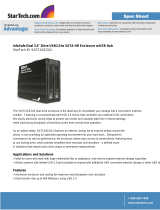
Dell™ PowerEdge™ R610 Technical Guidebook
6
THE DELL™ POWEREDGE™ R610
Inspired by customer feedback, the Dell PowerEdge R610 server is engineered to simplify data
center operations, improve energy eciency, and lower total cost of ownership. System commonality,
purposeful design, and service options combine to deliver a rack server solution that can help you
better manage your enterprise.
Strong IT Foundation
The Dell PowerEdge R610 is a key building block for today’s data center. Designed for versatility and high performance,
it provides many of the virtualization, system management, and energy-eciency features you need now and the
scalability necessary to change as your business grows. This general-purpose Intel
®
-based 2-socket 1U server is ideal
for corporate data centers and remote sites that require a dense, highly available single- or dual-processor server at an
excellent value.
Enhanced Virtualization
Featuring Intel
®
Xeon
®
-based architecture, embedded hypervisors, expanded memory footprint, and I/O, the Dell
PowerEdge R610 delivers exceptional overall system performance and significant virtual machine-per-server capacity
versus the previous generation. With optional factory-integrated virtualization capabilities, you get tailored solutions –
built with the latest technologies from Dell and our trusted partners – which allow you to streamline deployment and
simplify virtual infrastructures. Choose your hypervisor from market leaders such as VMware
®
, Citrix
®
, and Microsoft
®
,
and enable virtualization with a few mouse clicks.
Energy-Optimized Technologies
Dell’s advanced thermal control helps optimize performance while minimizing system power consumption, ultimately
driving energy eciency across our latest core data center servers. These enhancements, over previous generations,
include ecient power supply units right-sized for system requirements, improved system-level design eciency,
policy-driven power and thermal management, and highly ecient standards-based Energy Smart components. Dell's
advanced thermal control is designed to deliver optimal performance at minimum system and fan power consumption
resulting in our quietest mainstream 1U servers to date.
Purposeful Design
The R610 takes advantage of Dell’s system commonality. Once your IT managers learn one system, they understand
how to manage next-generation Dell servers. Logical component layout and power supply placement also provide a
straightforward installation and redeployment experience.
Simplified Systems Management
Gain more control with the next-generation Dell OpenManage™ suite of management tools. These tools provide ecient
operations and standards-based commands designed to integrate with existing systems.
Dell Management Console (DMC) helps simplify operations and create stability by shrinking infrastructure management
to one console. This console delivers a single view and a common data source into the entire infrastructure management.
Built on Symantec
®
Management Platform, it has an easily extensible, modular foundation that can provide basic hardware
management all the way up to more advanced functions such as asset and security management. DMC is designed to
reduce or eliminate manual processes enabling you to save time and money for more strategic technology usage.
Secure, ecient, and more user friendly than its predecessors, the Dell Unified Server Configurator (USC) delivers “Instant On”
integrated manageability through a single access point. You get quick, persistent access to the tool because it is embedded
and integrated into the system for increased flexibility and capabilities. The USC is a one-stop shop for deploying operating
systems with built-in driver installations, firmware updates, hardware configuration, and issue diagnoses.





















